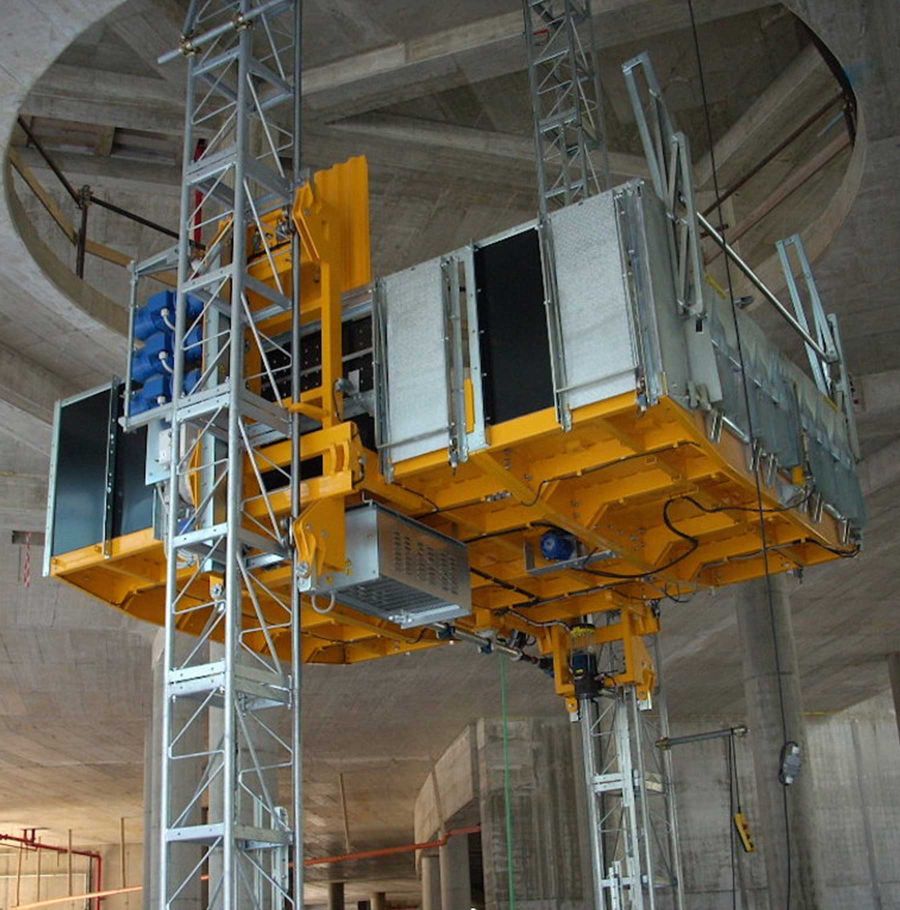
Benefits of Construction Site Hoists
Like elevators, the freight elevators are equipped with a pinion and rack-type lifting mechanism driven by electric motors and can reach heights up to 220 meters with baskets of dimensions suitable for lifting, in addition to people, all types of materials and bulky equipment too. In particular, the two-pillar goods lifts are specifically designed for lifting all types of materials and equipment, with an alternative use to loading castles in construction sites.
Monocolumn and bicolumn goods hoists available for hire guarantee
- quick and safe assembly directly from inside the cab or platform;
- reduction of access times at height;
- great reliability and ease of use;
- low maintenance cost;
- interchangeability of the components;
- easy handling and positioning with cranes or forklifts;
- versatility of use with consequent optimization of investments.
Available Construction Hoists
Technical Data
Capacity | From 300 up to 5000kg |
Lifting speed | From 12 up to 30mt/min |
Max anchored height | 220 mt |
Platform dimensions | From 0,80x1,35 mt up to 3,00x4,80 mt |
Power of the motors | From 1x1,1 kw up to 6x7,5 kw |
Input power range | 220 - 380 V - 50 Hz 230 - 400 V - 60 Hz 275 - 480 V - 60 Hz |
The rental of the hoists includes the following services:
- Operational and Engineering assistance in the preliminary phases;
- on-site supply and positioning;
- assembly and disassembly with qualified personnel;
- assistance guaranteed at every stage of the construction site.

Reduction of the times and costs of the building site around 30%
Material Hoists: greater efficiency for your projects
In the construction site, the crane is an essential element for the construction of a building. This is illustrated by the following example, 24 months of time necessary for the construction of a civil building: during the first 6 months, when the crane is necessary, the productivity of the building site is geared almost exclusively to reaching the roofing structures.
This is followed by the long process that includes all the laborious activities dedicated to finishing, in which a series of specialized companies present in the construction site must divide the use of the crane to move the materials and bring them up to specific levels. Under these conditions of use, any type of crane will never be able to perform more than six cycles per hour, thus marking the pace of work of all the workers on site.
If the crane was removed after the initial 6 months, replacing it with hoists and elevators, a cumbersome and expensive structure would be avoided. The solution with hoists and elevators would give a greater speed to the progress of the work, guaranteeing even greater speeding in the execution of all finishes on integrated use in the battery.
The use of such machines for the lifting of men and materials at high altitude would therefore drastically reduce the time and consequently the costs of the construction site, with an estimate estimated at around 30% of the entire production cost.
This is followed by the long process that includes all the laborious activities dedicated to finishing, in which a series of specialized companies present in the construction site must divide the use of the crane to move the materials and bring them up to specific levels. Under these conditions of use, any type of crane will never be able to perform more than six cycles per hour, thus marking the pace of work of all the workers on site.
If the crane was removed after the initial 6 months, replacing it with hoists and elevators, a cumbersome and expensive structure would be avoided. The solution with hoists and elevators would give a greater speed to the progress of the work, guaranteeing even greater speeding in the execution of all finishes on integrated use in the battery.
The use of such machines for the lifting of men and materials at high altitude would therefore drastically reduce the time and consequently the costs of the construction site, with an estimate estimated at around 30% of the entire production cost.












